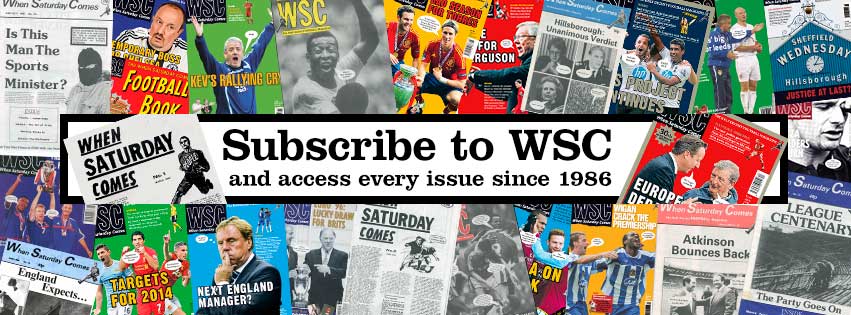There was a time when strike partnerships rolled off the tongue like superheroes and clubs even thought foreign players should be kept in pairs, as Harry Pearson explains
21 December ~ Recently it was announced that the divorce rate in Britain had reached an all-time high. Though there are reasonable claims that Total Football first flowered during a loosening of the Netherlands’ social strictures, the game’s tactics do not often reflect societal change. Quite the opposite in fact. Generally the wilder and more inventive the cultural climate the more stultifying the football – the offside trap flourished during the Jazz Age.
In this case, however, I feel there might be some correlation between what is happening on the pitch and across the nation. I don’t mean a festering sense of grievance fostered by arguments over custody of the ball, despite what the increasingly snarly atmosphere in Premier League technical areas may suggest (who’s to say that at some point Mark Hughes won’t appear dressed as Superman and handcuff himself to a heated chair in protest at Manchester City only allowing his team 15 minutes, twice a year). No, I refer to the breakdown of the enduring partnerships that were once the bedrock of the English game, duos who, like the Twin Towers of Wembley, once seemed so permanent, but are now no more than a tearful memory of simpler, happier times.
Where, for instance, are the managerial double acts, the John Sillett and George Curtises, the Alan Curbishley and Steve Gritts? Perhaps the dictator gets more done, but he rules unchecked by a compassionate alter-ego. Take the famous Swedish coaching partnership of Tommy “Baloo” Soderberg and Lars Lagerback. During the Swedes’ 2002 World Cup encounter with Senegal the pair were caught on camera having an exchange about whether to substitute Marcus Allback. The Villa striker was having a game that stunk like a dead man nailed to a skunk. Lagerback suggested to his partner that they should haul off Allback and Soderberg responded that to do so would humiliate the player so badly he might never recover. Lagerback countered that the team needed to hold the ball better and play higher up the field. Soderberg placed his hand on his heart and replied mournfully: “I am just saying sometimes I get so sad because he is having a really rough time.” Lagerback patted his partner on the shoulder and agreed to leave the fragile forward on the field. Sweden lost, but humanity was the winner.
These days strikers too tend to operate in a playboy role, up front alone, with various nifty stepover merchants scampering around behind them like an entourage. But from the 1960s through until the mid-1990s forwards operated in pairs. The best of these striking duos – John Toshack and Kevin Keegan, and Kenny Dalglish and Ian Rush for example – had surnames that were as closely linked in the public mind as those of Morecambe and Wise, Cagney and Lacey or Peters and Lee (ask your parents). They could be relied on to turn up for newspaper photoshoots dressed as Batman and Robin, Starsky and Hutch or Butch and Sundance.
Ted MacDougall and Phil Boyer never reached the glorious heights of strike partnerships as Francis Lee and Mike Summerbee, or Allan Clarke and Mick Jones, or got a nickname like Bristol Rovers duo Alan Warboys and Bruce Bannister who the press dubbed “Smash ’n’ Grab”, but their relationship was founded on trust and mutual dependence. In the five seasons they played together (two at Bournemouth and one each at York, Norwich and Southampton) they netted a barely credible 195 goals between them. The Inverness-born MacDougall tended to get the headlines – in his time with Bournemouth he hit the back of the net nine times in an FA Cup tie against Margate, and secured a £200,000 move to Manchester United back in the days when the British transfer record was £225,000 – but he was never anywhere near as effective without Boyer, who’d started his career at Derby, an early signing of another great couple, Brian Clough and Peter Taylor.
In the past football clubs believed in duos so much they also believed that foreign players, like guinea pigs, should be bought and kept in pairs: Frans Thijssen and Arnold Muhren at Ipswich, Ossie Ardiles and Ricardo Villa at Spurs, Johans Cruyff and Neeskens at Barcelona and Joe Baker and Denis Law at Torino are obvious examples. All of them gave value for money (though the latter more in the bars and gossip columns of Turin than on the pitch, obviously).
When Sunderland signed Jim Baxter from Rangers they also bought his cousin George Kinnell to stop the Slim One getting homesick. Baxter apparently got sick on many occasions during his spell on Wearside, though home wasn’t what caused it. He and Kinnell did everything together, including getting arrested during a pre-season tour to Canada for trying to buy booze using counterfeit currency.
Eventually Sunderland offloaded Baxter to Nottingham Forest while Kinnell ended up at Ayresome Park, Boro having shelled out £40,000 for him. The deal was not a success and the Holgate End serenaded the Scot with the infamous chant: “We paid £40,000 for Kinell/We paid £40,000 for Kinell/We paid £40,000 fucking hell.” It has been reported to me since by those who saw him play that Kinell was actually quite a tidy footballer, but a football crowd should never let the facts stand in the way of a good gag. Harry Pearson
This article first appeared in WSC 370, December 2017. Subscribers get free access to the complete WSC digital archive – you can find out more details here
